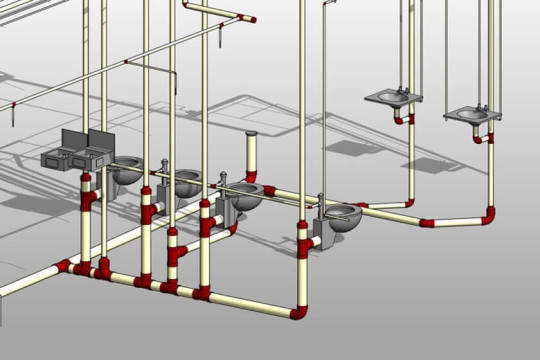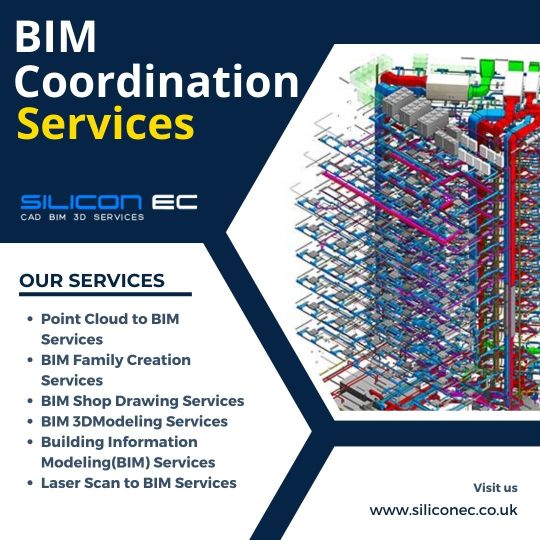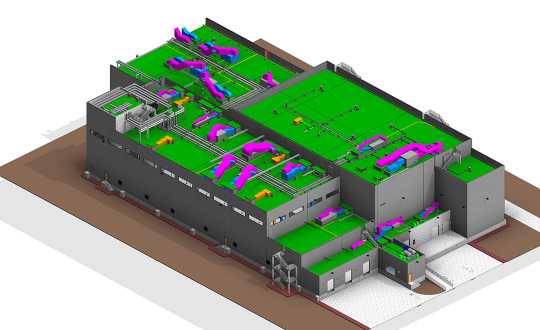#BIM for MEP Coordinator
Explore tagged Tumblr posts
Text
MEP Coordination Process with BIM for MEP Coordinators
The MEP Coordination Process involves integrating mechanical, electrical, and plumbing systems to ensure seamless interaction within a building project. Utilizing Building Information Modeling (BIM), an MEP Coordinator oversees this process by creating detailed 3D models that highlight potential conflicts and spatial constraints. BIM allows for real-time collaboration among various stakeholders, enhancing accuracy and efficiency. The BIM for MEP Coordinator uses BIM to detect clashes, streamline workflows, and optimize the design and installation phases, ultimately reducing costs and project timelines while ensuring high-quality, coordinated MEP systems.

0 notes
Text
MEP Coordination for Cost Reduction in Construction Projects

In construction projects, the MEP system plays a crucial role in making the building functional. To ensure synchronization, MEP coordination ensures keeping in mind the budget constraints.
Read more in detail to understand cost reduction in projects with MEP coordination.
#mep coordination#mep bim services#mep coordination services#mep coordination drawings#mep bim modeling services#mep drafting services#mep coordination process#bim mep coordination#mep 3d modeling#mep bim coordination services#mep bim coordination
3 notes
·
View notes
Text

BIM Careers: Building Your Future in the Digital AEC Arena
The construction industry is undergoing a digital revolution, and BIM (Building Information Modeling) is at the forefront. It's no longer just a fancy 3D modeling tool; BIM is a collaborative platform that integrates data-rich models with workflows across the entire building lifecycle. This translates to exciting career opportunities for those who can harness the power of BIM.
Are you ready to step into the octagon of the digital construction arena? (Yes, we're keeping the fighting metaphor alive!) Here's a breakdown of the in-demand skills, salary ranges, and future prospects for BIM professionals:
The In-Demand Skillset: Your BIM Arsenal
Think of your BIM skills as your tools in the digital construction toolbox. Here are the top weapons you'll need:
BIM Software Proficiency: Mastering software like Revit, ArchiCAD, or Navisworks is crucial. Understanding their functionalities allows you to create, manipulate, and analyze BIM models.
Building Science Fundamentals: A solid grasp of architectural, structural, and MEP (mechanical, electrical, and plumbing) principles is essential for creating BIM models that reflect real-world construction realities.
Collaboration & Communication: BIM thrives on teamwork. The ability to collaborate effectively with architects, engineers, and other stakeholders is paramount.
Data Management & Analysis: BIM models are data-rich. Being adept at data extraction, analysis, and interpretation unlocks the true potential of BIM for informed decision-making.
Problem-Solving & Critical Thinking: BIM projects are complex. The ability to identify and solve problems creatively, while thinking critically about the design and construction process, is invaluable.
Salary Showdown: The BIM Payday Punch
Now, let's talk about the real knock-out factor – salaries! According to Indeed, BIM professionals in the US can expect an average annual salary of around $85,000. This number can vary depending on experience, location, and specific BIM expertise. Entry-level BIM roles might start around $60,000, while BIM Managers and BIM Specialists with extensive experience can command salaries exceeding $100,000.
Future Forecast: A Bright BIM Horizon
The future of BIM is bright. The global BIM market is projected to reach a staggering $8.8 billion by 2025 (Grand View Research). This translates to a continuous rise in demand for skilled BIM professionals. Here are some exciting trends shaping the future of BIM careers:
BIM for Specialty Trades: BIM is no longer just for architects and engineers. We'll see increased adoption by specialty trades like HVAC technicians and fire protection specialists.
Integration with AI and Machine Learning: Imagine BIM models that can predict potential issues or suggest optimal design solutions. AI and machine learning will revolutionize BIM capabilities.
VR and AR for Enhanced Collaboration: Virtual Reality (VR) and Augmented Reality (AR) will allow for immersive BIM model walkthroughs, facilitating better collaboration and design communication.
Ready to Join the BIM Revolution?
The BIM landscape offers a dynamic and rewarding career path for those with the right skills. If you're passionate about technology, construction, and shaping the future of the built environment, then BIM might be your perfect career match. So, hone your skills, embrace the digital revolution, and step into the exciting world of BIM with Capstone Engineering!
#tumblr blogs#bim#careers#buildings#bim consulting services#bim consultants#construction#aec#architecture#3d modeling#bim coordination#consulting#3d model#bimclashdetectionservices#engineering#MEP engineers#building information modeling#oil and gas#manufacturing#virtual reality#collaboration#bim services#uaejobs
2 notes
·
View notes
Text
MEP systems are the backbone of modern buildings, ensuring energy efficiency, functionality, and comfort. By implementing best practices in MEP design and execution, stakeholders can minimize costly reworks, avoid project delays, and enhance the building’s long-term sustainability. From power distribution to HVAC systems, a well-coordinated MEP model is critical for improving performance, reducing utility bills, and providing safe, comfortable environments for occupants. Whether it's a commercial space or a residential building, precise MEP design impacts both cost optimization and overall satisfaction.
0 notes
Text
The Vital Role of MEP Coordination in Enhancing Building Design & Quality
Coordination in construction industry is one of the key issues as it is faster evolving industry and it is obvious that the issue of communication between various disciplines takes important role. It is one of the important points or the key factor which significantly influences the success of the building project that is MEP (Mechanical, Electrical, and Plumbing) coordination. In the blog post…

View On WordPress
0 notes
Text
How MEP BIM Coordination Can Help Achieve Design Accuracy
Understanding the critical role of MEP BIM coordination is vital for achieving precise design outcomes in construction projects. BIM technology helps detect and address design inconsistencies, leading to enhanced coordination and accuracy. Read here to learn how MEP BIM coordination services can help achieve design accuracy.
#MEP BIM coordination services#MEP BIM coordination#bim services#asc technology solutions#bim outsourcing services#bim services provider#mep bim services
1 note
·
View note
Text
Optimize Your Construction Projects with Advanced BIM Coordination
Advanced BIM coordination services excel at integrating all project components, ensuring coherence and precision. By reducing clashes and enhancing model accuracy, significant time and resource savings are achieved. Our coordinated approach leads to fewer on-site issues, streamlined workflows, and enhanced collaboration among project teams. Experience optimized project execution that boosts productivity and delivers superior results. Benefit from a well-coordinated construction process that is both efficient and cost-effective. Please get in touch with us right now at https://agoncoordination.com/.
1 note
·
View note
Text
Revolutionizing Construction: The Role of BIM in MEPF

The construction industry has witnessed a revolutionary transformation in recent years, with technological advancements playing a pivotal role in streamlining processes and enhancing efficiency. Building Information Modeling (BIM) has emerged as a game-changer, particularly in the Mechanical, Electrical, Plumbing, and Fire Protection (MEPF) disciplines. This article delves into the profound impact of BIM on MEPF, exploring how this innovative technology is reshaping the construction landscape.
Understanding BIM in MEPF
Digital representations of a building's structural and operational features are used in the collaborative BIM process. In the context of MEPF, BIM involves creating and managing a 3D model that integrates mechanical, electrical, plumbing, and fire protection systems within a virtual environment. This digital model serves as a comprehensive and centralized source of information for all stakeholders involved in the construction process.
Improved Coordination and Clash Detection
One of the primary advantages of employing BIM in MEPF is the enhanced coordination it facilitates. Traditional construction methods often led to clashes and conflicts among different systems, resulting in costly rework and delays. BIM enables real-time clash detection by overlaying the individual MEPF models, allowing project teams to identify and resolve conflicts before they materialize on the construction site. This proactive approach minimizes the likelihood of on-site issues, ensuring a smoother construction process.
Enhanced Collaboration and Communication
BIM acts as a collaborative platform that fosters communication among project stakeholders. MEPF professionals can work concurrently on the same model, reducing the time spent on coordination and ensuring that all systems are seamlessly integrated. This collaborative environment promotes transparency and efficiency, allowing teams to share information and make informed decisions throughout the project lifecycle. Improved communication leads to fewer errors, reduced rework, and ultimately, increased project success.
Accurate Quantity Takeoffs and Cost Estimations
BIM in MEPF goes beyond visual representations; it also serves as a robust tool for accurate quantity takeoffs and cost estimations. The detailed information embedded in the digital model enables automated calculations of material quantities, helping project managers and estimators generate precise cost estimates. This capability enhances budgeting accuracy and allows stakeholders to make informed financial decisions throughout the construction process.
Lifecycle Management and Maintenance
BIM's impact extends beyond the construction phase into the operational life of a building. The digital model contains valuable information about the MEPF systems, including specifications, maintenance schedules, and equipment details. This data facilitates efficient facility management, enabling owners and facility managers to optimize maintenance processes, schedule inspections, and make informed decisions about system upgrades or replacements. BIM in MEPF ensures that the benefits of digitalization persist long after the construction dust settles.
Sustainable Design and Energy Efficiency
In an era where sustainability is a top priority, BIM plays a crucial role in promoting environmentally friendly practices in MEPF design. The 3D modeling capabilities allow designers to simulate and analyze the performance of MEPF systems, optimizing them for energy efficiency and sustainability. BIM enables the evaluation of alternative design scenarios, helping teams identify the most environmentally friendly and cost-effective solutions. This focus on sustainability aligns with the global push towards green construction practices.
Regulatory Compliance and Documentation
MEPF systems are subject to stringent regulatory requirements, and compliance is non-negotiable. BIM simplifies the process of ensuring regulatory compliance by providing a centralized repository for all relevant documentation. From equipment specifications to safety standards, BIM ensures that every detail is documented and easily accessible. This not only streamlines the approval process but also serves as a comprehensive record that can be invaluable during audits or inspections.
Conclusion
In conclusion, the role of BIM services in revolutionizing construction, particularly in the MEPF disciplines, cannot be overstated. The technology's ability to enhance coordination, improve collaboration, streamline cost estimation, facilitate lifecycle management, promote sustainability, and ensure regulatory compliance makes it an indispensable tool for modern construction projects. As the construction industry continues to evolve, embracing BIM in MEPF is not just an option but a strategic imperative for those seeking to stay ahead in a competitive and dynamic environment.
0 notes
Text
The Importance of MEP Coordination in Construction Project

Explore the critical role of MEP coordination and the benefits of MEP BIM coordination services in ensuring efficient building design and construction.
Discuss the significance of MEP coordination and the advantages of MEP BIM coordination services in delivering effective building design and construction. Mechanical, electrical, and plumbing (MEP) systems are the core of any building's functioning.
These systems are tasked with providing buildings with heating, cooling, ventilation, electricity, water supply, sanitation, and fire protection. Efficient MEP design is a major factor in the perfect functioning of the building and also ensures the comfort and safety of the occupants.
0 notes
Text
The Power of MEP Outsourcing in Reducing Rework and Costs

In the construction industry, time and money are two invaluable resources. Any delay or cost overrun can significantly impact a project's success. Mechanical, Electrical, and Plumbing (MEP) systems play a crucial role in the functionality and efficiency of a building. However, their installation and integration can be complex and prone to errors, leading to rework and inflated expenses. To combat these challenges, many construction firms are turning to MEP outsourcing services as a strategic solution.
1. Specialized Expertise
MEP outsourcing brings on board dedicated professionals with specialized knowledge and experience in mechanical, electrical, and plumbing systems. These experts are well-versed in industry standards, regulations, and best practices, minimizing errors and rework stemming from inexperienced or untrained staff.
2. Streamlined Project Timelines
With focused teams dedicated solely to MEP tasks, project timelines are streamlined. This acceleration ensures projects progress efficiently, meeting deadlines and client expectations. Shorter timelines translate directly to cost savings by reducing labor and overhead expenses.
3. Cost-effectiveness
Outsourcing MEP tasks optimizes resource allocation, mitigating unnecessary expenditures. External firms often possess cutting-edge tools and technologies, sparing construction companies from investing in expensive equipment or training programs. Furthermore, firms can scale their workforce as needed, avoiding the burden of maintaining a large in-house team during quiet periods.
4. Mitigated Liability and Risk
BIM Services Provider shifts responsibility for design, installation, and performance to external firms. This reduces legal and financial exposure for construction companies, as outsourcing partners assume accountability for errors or failures. In the event of defects, the burden of litigation and reputational damage is minimized.
5. Quality Assurance
External firms adhere to rigorous quality standards and regulatory requirements, ensuring MEP systems meet industry benchmarks for performance, safety, and sustainability. Stringent quality control measures minimize defects and deficiencies, decreasing the need for rework and warranty claims.

6. Fostering Collaboration and Innovation
Partnering with specialized firms encourages knowledge exchange and collaboration, fostering innovation and creative problem-solving. By tapping into a broader network of expertise, construction companies can drive innovation, optimize designs, and improve project outcomes.
7. Scalability
Point Cloud to Revit Modeling allows construction firms to scale their operations according to project demands. This flexibility enables firms to maintain agility in a dynamic market environment, adjusting resource allocation and workforce size as needed to meet project requirements.
8. Risk Management
Outsourcing partners assume responsibility for managing risks associated with MEP systems, including design errors, material procurement, and installation challenges. This reduces the burden on construction companies and allows them to focus on core competencies while minimizing exposure to potential liabilities.
9. Enhanced Focus on Core Competencies
By outsourcing MEP tasks, construction firms can redirect internal resources and focus on their core competencies, such as project management, client relations, and overall project delivery. This allows for greater efficiency and effectiveness in delivering high-quality construction projects.
10. Competitive Advantage
Embracing MEP outsourcing gives construction firms a competitive edge in the market. By leveraging specialized expertise, streamlining processes, and optimizing resource allocation, firms can deliver projects more efficiently, cost-effectively, and profitably than their competitors.
In conclusion, MEP Outsourcing Companies in India offers construction firms a powerful strategy for reducing rework and costs while enhancing project efficiency and quality. By harnessing specialized expertise, streamlining processes, and mitigating risks, outsourcing partners enable construction companies to deliver successful projects on time and within budget, ultimately driving competitiveness and profitability in the industry.
#mep coordination services#mep bim coordination services#clash detection and bim coordination services#mep clash detection services#clash detection services#bim coordination services#3d modeling services#scan to bim services
0 notes
Text
The Necessity of MEP BIM for Contractors in Construction Projects
In the rapidly evolving construction industry, adopting Building Information Modeling (BIM) for Mechanical, Electrical, and Plumbing (MEP) systems has become increasingly crucial for contractors. MEP BIM integration streamlines design processes enhances collaboration, and significantly improves the overall efficiency and accuracy of construction projects. This blog explores the necessity of MEP BIM for contractors and its transformative impact on construction projects.
What is MEP BIM?
MEP BIM refers to using BIM technology to design, manage, and integrate mechanical, electrical, and plumbing systems within a building project. It involves creating detailed 3D models that encapsulate all the specifications, spatial relationships, and functionalities of MEP systems. These models enable stakeholders to visualize, simulate, and optimize MEP components before construction begins.
Benefits of MEP BIM for Contractors
Enhanced Collaboration and Coordination
MEP BIM fosters better communication and collaboration among various stakeholders, including architects, engineers, and contractors. The integrated 3D models provide a comprehensive view of the project, allowing all parties to understand the design and make informed decisions. This collaborative approach reduces miscommunications and ensures that everyone is on the same page, leading to smoother project execution.
Clash Detection and Risk Mitigation
One of the most significant advantages of MEP BIM is its ability to detect clashes and conflicts early in the design phase. By simulating the integration of MEP systems within the building structure, contractors can identify and resolve issues before they escalate, minimizing the risk of costly rework and project delays.
Improved Accuracy and Efficiency
MEP BIM models are highly detailed and accurate, which reduces the likelihood of errors during construction. These models provide precise dimensions, specifications, and installation guidelines, ensuring that the MEP systems fit perfectly within the building. This level of accuracy enhances construction efficiency, reduces waste, and optimizes resource utilization.
Cost and Time Savings
By detecting clashes early, improving collaboration, and ensuring accurate installations, MEP BIM helps significantly reduce project costs and timelines. Contractors can avoid unexpected expenses related to rework and material waste, leading to more predictable budgeting and scheduling.
Related blog: Why Did Contractors Require MEP BIM For A Construction Project?
Enhanced Project Visualization
The 3D models created through MEP BIM offer a realistic visualization of the MEP systems within the building. This visualization aids in better planning and decision-making, as stakeholders can see the outcome and make adjustments as needed. It also helps in communicating complex designs to clients and other non-technical stakeholders.
Sustainability and Energy Efficiency
MEP BIM allows contractors to simulate and analyze the energy performance of the building. By optimizing MEP systems for energy efficiency, contractors can design sustainable buildings that meet environmental standards and reduce operational costs. This is increasingly important as the industry moves towards greener construction practices.
Implementation Challenges and Solutions
While the benefits of MEP BIM are clear, its implementation can pose certain challenges. These include the need for specialized training, the cost of software, and the integration of BIM into existing workflows. However, these challenges can be overcome through:
Investing in Training and Development: Providing comprehensive training programs for staff to ensure they are proficient in using BIM tools and techniques.
Choosing the Right Software: Select BIM software that aligns with the specific needs and capabilities of the construction firm.
Gradual Integration: Implementing BIM in phases, starting with smaller projects to build expertise before moving on to larger, more complex ones.
Conclusion
The adoption of MEP BIM is no longer a luxury but a necessity for contractors in the modern construction landscape. Its ability to enhance collaboration, improve accuracy, reduce costs, and promote sustainability makes it an indispensable tool for successful project delivery.
0 notes
Text
Integrating BIM in MEP Projects for Cost-Benefit Analysis

MEP plays an important role in construction, and cost estimation is significant to ensure project success and failure. Understand how integrating BIM can help in cost-benefit analysis for MEP projects. UniquesCADD is a leading BIM company, offering segments of BIM services and MEP services with a team of trained professionals and the use of cutting-edge technology.
#mep bim services#mep coordination#mep bim consultant#mep services#mep bim coordination#mep bim modeling#3d mep modeling#bim coordination services
2 notes
·
View notes
Text
Best BIM Coordination Services in Londonderry, UK at a low price

Welcome to Silicon EC UK Limited, your trusted partner for cutting-edge BIM Coordination Services in the United Kingdom. As a leading company in the industry, we specialize in providing comprehensive BIM solutions to enhance the efficiency and precision of construction projects. We stay at the forefront of technological advancements, incorporating the latest tools and methodologies to deliver innovative and efficient BIM coordination services.
Choose Silicon EC UK Limited for unparalleled BIM coordination services that bring your construction projects to new heights of efficiency and accuracy. Partner with us to transform your visions into reality, with the assurance of reliable and cutting-edge BIM solutions.
Visit our Website:
https://www.siliconec.co.uk/bim-services/bim-coordination.html
#BIM#Building Information Modeling#CAD Drawing#CAD Design#CAD Drafting#BIM Coordination Services#BIM Modeling Services#BIM Coordinated model#BIM Services Company#BIM Coordination Outsourcing Company#BIM Coordination#BIM Coordination Services in London#BIM Coordination London#3D BIM Coordination Services#3D BIM Coordination Services in London#3D BIM Coordination in London#MEP BIM Coordination Services London#3D BIM Coordination#MEP Coordination Services London#MEP BIM Coordination in London#MEP BIM Coordination Services#BIM Coordination Process London#MEP Coordination Services#BIM Model Coordination London#BIM Modeling Services in London#BIM Model Coordination#MEP BIM Coordination#BIM Coordination process
0 notes
Text

At Hitech BIM Services, we offer BIM coordination services in Boston, leveraging our expertise in BIM modeling to enhance construction projects. Our Boston BIM services focus on providing MEP coordination, ensuring seamless integration of mechanical, electrical, and plumbing systems. Utilizing software like Revit and Navisworks, we reduce the risk of construction errors, enhancing overall project efficiency.
#BIM Coordination Services Boston#Boston BIM Services#Boston#USA#MEP Coordination#BIM Services Boston#Revit
0 notes
Text

#education#training#mep services#mep design#mep bim coordination#mep shop drawings#mep clash detection#gas and oil
1 note
·
View note
Text
youtube
Take on complex construction with MEP BIM coordination - ASC Technology Solutions
It's important for architecture, engineering, and construction professionals to understand MEP BIM coordination. This involves ensuring that buildings' heating, electrical, plumbing, and fire protection systems all work well together. Our video demonstrates how this coordination process helps identify and resolve system issues early, leading to smoother installations and reducing the need for changes later. MEP BIM coordination also aids in creating detailed construction plans and expediting complex construction projects. You can rely on the expertise of ASC Technology Solutions for MEP BIM coordination services. We specialize in seamlessly integrating various building components, streamlining the construction process.
Visit ASC Technology Solutions for BIM Coordination: https://asctechno.com/mep-coordination-services/
1 note
·
View note